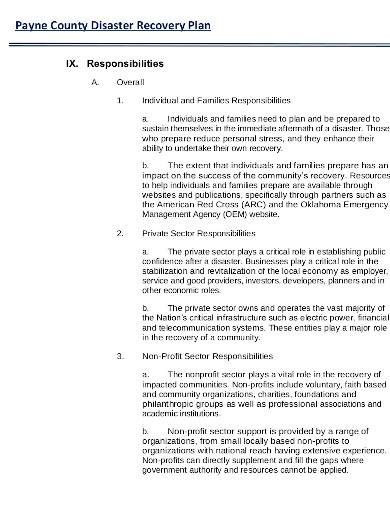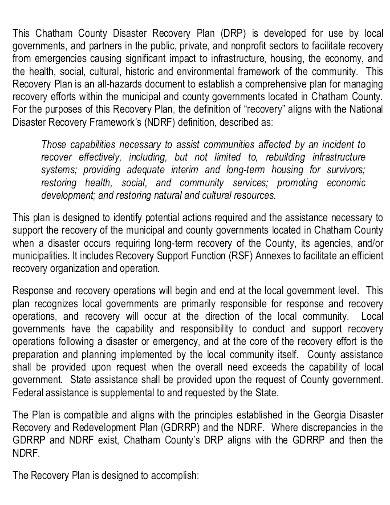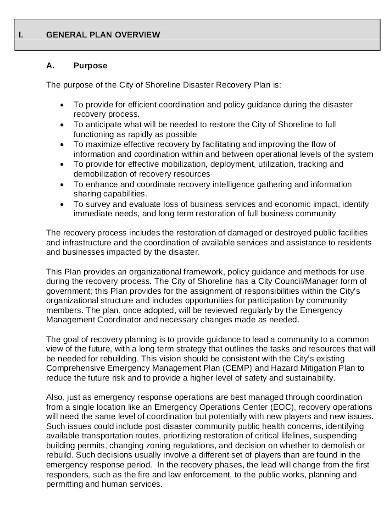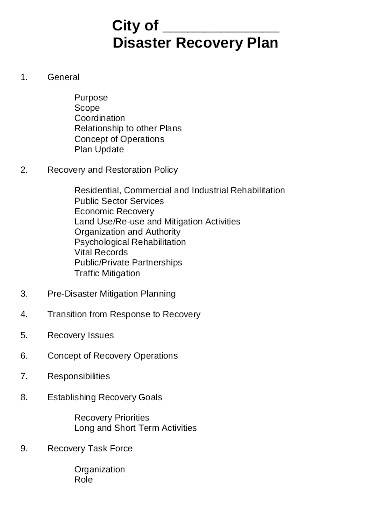World War II left more than just ruined homes but also displaced families and loved ones. The period between 1939 and 1945 became one of humanity’s greatest and deadliest disaster, killing over 70 million people. After the war, organizations were made, including various ones which focus on serving the rest of the population without requiring payments for salaries of the providers, in short, nonprofit and charity organizations. And even after many years have passed, there are still lots of organizations maintaining the same virtue of helping those in need without asking for returns. But, it doesn’t mean they don’t fall into disasters and risks, too. That’s why, if you are a member or maybe will be establishing a nonprofit, you must have a charity disaster recovery plan before any problem, big and small, comes.
FREE 4+ Charity Disaster Recovery Plan Samples & Templates in PDF
1. Charitable Disaster Recovery Plan
2. Charity Disaster Recovery Plan
3. Foundation Disaster Recovery Plan Template
4. NGO Disaster Recovery Plan
5. Disaster Recovery Plan Template
How to Create a Charity Disaster Recovery Plan
During various disasters, be it manmade or one done by nature, charities and nonprofits pose a significant role in disaster recovery providing immediate help to the affected ones. And, just like any other organizations and companies, nonprofits too have plans that make them more prepared when a disaster hits. So, your own organization should also have a plan, one that specifically prepares and protects the organization from devastation. Read on below to know the tips that you can use to create a sustainable and efficient charity disaster recovery plan:
1. Make a List
List every asset, property, membership details, procedures, and everything that needs to be in a documented list for your organization. But, most importantly, list the details of the organization’s assets and properties which can gain profit in the event of financial loss or need. Don’t forget to include the locations of each, as well as the ownership information, and the legal forms it accompanies.
2. Identify Common and Probable Disasters
Disasters are accidents, but although not preventable, some of them can be foreseen. You and the rest of the charity or nonprofit organization’s members and officials can work together to identify and discuss what the possible disasters are that your organization may face, be it for a year or two or for many years to come. Some of the common disasters would be those involved in nature, such as flood, earthquakes, and forest fires. On the one hand, you can also include unexpected ones, including epidemics and illness-related outbreaks in the state or county where the organization’s office is located. Be sure to add every possible and foreseeable disaster in the list, for no one can really be utterly over-prepared if the most feared happens.
3. Acknowledge and Enlist the Essential People
Everyone in a nonprofit organization is essential, including the charity volunteers, but not everyone is required to report at the office or headquarter when disasters arise. It can be a challenging decision to decide who the essential ones are, as they are the people who will be responsible for remaining to work for the organization amid anything. But, one way for you to do this is by focusing on the people. members, or volunteers who hold roles, such as the officers and those who bridge the communication between the organization to every member and beneficiary around the globe.
4. Be Specific With Your Solutions
There is no room for vagueness in times of disasters, so you should be specific with your solutions and enumerate tasks and assignments that each of your chosen essential members or volunteers must do. Other pieces of information that you can include in your solutions would be the time to complete each task and the budget plan.
5. Include Alternatives
When Plan A does not work, then off you go to Plan B, and when it didn’t work out too, then there’s Plan C, D, E, F, up to Z. In short, your charity organization must have contingency and alternative plans in the event that your other options failed. Identifying these plans must include the cause and effect, and the risks of pursuing such plans as well.
What is a charity disaster recovery plan?
A charity disaster recovery plan is like a first aid kit for nonprofits and charity organizations like yours. It allows the organization to be prepared in the event that there is a disaster or unexpected incident. The plan can include emergency contingency plans, budget plans, project plans, and other pieces of information needed to sustain the charity organization throughout the period of the disaster.
Is there a difference between a continuity plan to that of a charity disaster recovery plan?
Yes, there is a difference, and it centres explicitly on the time when the plans are to be mandated. Continuity plans refer to operational procedures of the organization only, while the latter focuses on how the organization can address the current disaster and days after the disaster occurs.
Can I reuse the SampleTemplates charity disaster recovery plan samples and templates after downloading it?
Yes, of course, you can reuse the plan samples and templates. In fact, you can even update your final edited version of the plan from time to time. All you have to prepare is an editing application software program and the device that you will use to edit and save the plan for your organization.
Establishing a charity disaster recovery plan can be a challenging task to accomplish, but it’s essential, for, without it, an organization may break once there’s the first sight of a disaster. And the worst part is, the organization may no longer be able to stand up again, because of the failure to have a recovery plan. Therefore, don’t waste any more time and begin crafting your plans today with the use of our sample forms and templates above.
Related Posts
FREE 12+ Sample Event Sponsorship Letter Templates in PDF ...
FREE 10+ Charity Data Protection Policy Samples & Templates in ...
Sample Supplier Evaluation
FREE 8+ Concert Program Templates in PDF
FREE 6+ Sample Non-Profit Organizational Chart Templates in MS ...
Fundraising Proposal Template
FREE 45+ Event Proposals in PDF MS Word | Pages | Google Docs
FREE 10+ Charity Profile Samples & Templates in MS Word PDF
FREE 10+ Academic Research Plan Samples and Templates in PDF
FREE 31+ Event Proposal Templates in MS Word PDF | Pages ...
FREE 10+ Project Scope Statement Samples in PDF MS Word
FREE 10+ Market Research Plan Samples & Templates in MS Word ...
FREE 14+ Event Marketing Plan Templates in PDF MS Word
Sample Non Profit Budget Template
FREE 10+ Charity Volunteer Application Form Samples & Templates ...





